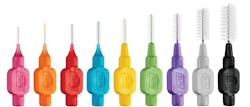The role of interdental cleaning for oral health, general health, and quality of life
According to the World Dental Federation (FDI), the definition of oral health is “multifaceted and includes the ability to speak, smile, smell, taste, touch, chew, swallow, and convey a range of emotions through facial expressions with confidence and without pain, discomfort, and disease of the craniofacial complex.”1 With this definition in mind, oral health is an undeniable part of general health and well-being.
The broad consequences of oral disease
Periodontal disease is common worldwide. It affects approximately 50% of the adult population, and severe periodontitis prevalence varies from 10% to 15%. Prevalence figures are positively associated with increasing age.2-4 Given the massive effects of the disease, it becomes clear that it should be a matter of global concern.
First, there is growing scientific support for a link between periodontal disease and several general diseases—e.g., cardiovascular disease, diabetes, and obesity. Thus, oral diseases are no longer considered local problems affecting just the oral cavity, but, rather, systemic diseases with consequences for overall health.5
Research has also shown a significant association between periodontal disease and oral health-related quality of life—independent of factors such as age, gender, and other dental problems.6 The disease can contribute to anxiety, low self-esteem, and feelings of shame and vulnerability.7
Oral diseases also have a vast impact from a financial perspective. In 2015, on a global basis, the total cost was shown to be $544.41 billion, where direct costs (measured as dental expenditures costs) accounted for $356.80 billion and indirect costs (measured as productivity losses) for $187.61 billion. Among oral diseases, periodontitis was the second biggest cause for global productivity costs.8 Severe periodontitis accounts for $54 billion yearly due to indirect costs.9
Causes and prevention
Dental professionals have a central role in preventing disease through a health-promoting approach based on science and proven clinical experience. Evaluating individual needs and conditions and weighing them together with scientific support should form the basis for patient instructions and recommendations, thus creating the best possible foundation for patient compliance and long-lasting oral health.
There are several risk factors for the development of periodontitis. Most important is the accumulation of a plaque biofilm along and below the gingival margin. Control and removal of this biofilm are of utmost importance to maintain oral health. The significance of good oral hygiene in order to prevent oral disease is, therefore, indisputable.
Toothbrushing and interdental cleaning are cornerstones to achieve high-quality oral hygiene. Interdental cleaning is associated with lower levels of periodontal disease, and periodontal health increases as the use of interdental cleaning devices becomes more frequent.10 The recommendation of an interdental cleaning device needs to be tailored specifically for each patient, but an interdental brush is preferred for the majority of the adult population.
A meta-review concluded that there is consistent evidence for interdental brushes being the most effective devices for interdental plaque removal.11 This is also stated in the report from the 11th European Workshop in Periodontology on the primary prevention of periodontitis.2 According to the working group, interdental brushes are the preferred choice for interdental cleaning, while floss is an alternative only when sites are too narrow for the interdental brush and show gingival and periodontal health. These results were confirmed in a network meta-analysis where interdental brushes displayed the best result regarding gingival inflammation, plaque reduction, and pocket reduction.12
From the presented articles, it appears that interdental brushes, when compared with other manual cleaning devices, have the highest efficacy in terms of plaque removal and periodontal parameters. Every recommendation regarding interdental cleaning devices must be customized for patients, taking into consideration the sizes and shapes of the interdental spaces. In addition, once interdental brushes are recommended for patients, dental professionals must instruct them regarding the appropriate size(s) of the brush and proper techniques.13
Conclusion
Current research emphasizes the importance of good oral hygiene in maintaining oral health and its consequences for general health and quality of life. Because the most common oral diseases are predominantly interdental diseases, preventive efforts must include interdental cleaning as an adjunct to toothbrushing in daily home care. In achieving optimal plaque control, the interdental brush is the preferred device for most of the global adult population.
A preventive approach is well in line with the global goals for oral health 2020 from FDI, where one of the targets is to increase the number of people with a healthy periodontium in all age groups.14 FDI also has a vision for 2020 of ensuring that oral health is recognized and accepted as a core element of general health and well-being.15 In light of the financial reports, a preventive approach is also most likely beneficial from an economic perspective, since it will limit the need for other dental treatments.
References
1. Glick M, Williams DM, Kleinman DV, Vujicic M, Watt RG, Weyant RJ. A new definition for oral health developed by the FDI World Dental Federation opens the door to a universal definition of oral health. Int Dent J. 2016;66(6):322-324. doi:10.1111/idj.12294
2. Chapple IL, Van der Weijden F, Doerfer C, et al. Primary prevention of periodontitis: managing gingivitis. J Clin Periodontol. 2015;42(suppl 16):S71-S76. doi:10.1111/jcpe.12366.
3. Petersen PE, Ogawa H. The global burden of periodontal disease: towards integration with chronic disease prevention and control. Periodontol 2000. 2012;60(1):15-39. doi:0.1111/j.1600-0757.2011.00425.x
4. Eke PI, Dye BA, Wei L, et al. Update on prevalence of periodontitis in adults in the United States: NHANES 2009 to 2012. J Periodontol. 2015;86(5):611-622. doi:10.1902/jop.2015.140520
5. Holmstrup P, Damgaard C, Olsen I, et al. Comorbidity of periodontal disease: Two sides of the same coin? An introduction for the clinician. J Oral Microbiol. 2017;9(1):1332710. doi:10.1080/20002297.2017.1332710
6. Masood M, Younis LT, Masood Y, Bakri NN, Christian B. Relationship of periodontal disease and domains of oral health-related quality of life. J Clin Periodontol. 2019;46(2):170-180. doi:0.1111/jcpe.13072
7. Herrera D, Meyle J, Renvert S, Jin L. White paper on prevention and management of periodontal diseases for oral health and general health. FDI World Dental Federation. https://www.fdiworlddental.org/sites/default/files/media/resources/gphp-2018-white_paper-en.pdf.
8. Righolt AJ, Jevdjevic M, Marcenes W, Listl S. Global-, regional-, and country-level economic impacts of dental diseases in 2015. J Dent Res. 2018;97(5):501-507. doi:10.1177/0022034517750572
9. Listl S, Galloway J, Mossey PA, Marcenes W. Global economic impact of dental diseases. J Dent Res. 2015;94(10):1355-1361. doi:10.1177/0022034515602879
10. Marchesan JT, Morelli T, Moss K, et al. Interdental cleaning is associated with decreased oral disease prevalence. J Dent Res. 2018;97(7):773-778. doi:10.1177/0022034518759915
11. Sälzer S, Slot DE, Van der Weijden FA, Dörfer CE. Efficacy of inter-dental mechanical plaque control in managing gingivitis – a meta-review. J Clin Periodontol. 2015;42(suppl 16):S92-S105. doi:10.1111/jcpe.12363
12. Kotsakis GA, Lian Q, Ioannou AL, Michalowicz BS, John MT, Chu H. A network meta-analysis of interproximal oral hygiene methods in the reduction of clinical indices of inflammation. J Periodontol. 2018;89(5):558-570. doi:10.1002/JPER.17-0368
13. Claydon NC. Current concepts in toothbrushing and interdental cleaning. Periodontol 2000. 2008;48(1):10-22. doi:10.1111/j.1600-0757.2008.00273.x
14. Hobdell M, Petersen PE, Clarkson J, Johnson N. Global goals for oral health 2020. Int Dent J. 2003;53(5):285-288. doi:10.1111/j.1875-595x.2003.tb00761.x
15. Glick M, da Silva OM, Seeberger GK, et al. FDI vision 2020: shaping the future of oral health. Int Dent J. 2012;62(6):278-291. doi:10.1111/idj.12009
About the Author

Anna Nilvéus Olofsson, DDS
Anna Nilvéus Olofsson, DDS, is a 1992 graduate from the Institute of Odontology at the University of Gothenburg. With a research focus in the periodontal field, she was awarded an Odont. Lic. degree in 2001 with the thesis, “The plasminogen activating system in the periodontal area.” In 2004, she became a certified specialist in pediatric dentistry at the Faculty of Odontology at Malmö University. Dr. Nilvéus Olofsson has been the manager of odontology and scientific affairs at TePe Oral Hygiene Products since 2009.
